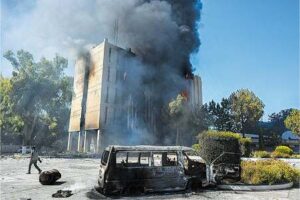PESHAWAR — In a secluded corner of Tirah Valley, surrounded by jagged mountains and dense forests, Luqman Afridi struggles with a painful memory.
Last year, Afridi, a small-time herdsman in Khyber tribal district, faced a decision no villager wishes to confront. Leopards had killed his goats—three prized animals he had raised to support his family.
Left without support, he chose a path that has become a grim ritual in this part of Pakistan: he killed two leopard cubs. His actions, captured in photos that surfaced on social media, became a symbol of the complex battle between man and wildlife, survival and conservation.
“Our losses were heavy,” Afridi explains, eyes fixed on the rugged terrain surrounding his home. “No one from the government came. We waited for support, but it never arrived.” His decision, born out of necessity, speaks to a broader reality in Pakistan’s mountainous north, where livestock is often a family’s most valuable asset, and leopards are perceived as a grave threat to livelihoods.
Also Read: Indus Blind Dolphin Conservation: KP Approves Rs50 Million Plan
The Unspoken Conflict
This tragic dance between humans and leopards has intensified in Khyber Pakhtunkhwa and Azad Kashmir. Over the past year alone, the escalating conflict has resulted in the deaths of at least 25 common leopard, each a member of an already endangered population. The killings echo a harsh truth: for all its rugged beauty, Pakistan’s northern landscapes are increasingly hostile to wildlife. As human populations grow, leopards are being driven from their habitats, forced to scavenge closer to villages. With each encounter, both human and leopard edge closer to a fatal confrontation.
Abdul Halim Marwat, Divisional Forest Officer for Wildlife in Khyber, frames it bluntly: “These forests were once quiet, abandoned even, due to militancy. Leopards thrived in these empty spaces. But as people returned, so did their livestock, and the inevitable clash began.” In 2006 and 2007, residents of Tirah and nearby valleys had fled from the conflict, abandoning their homes and livestock.
Also Read: Govt Takes Action to Protect Endangered birds in KP
Leopards, free from human disturbance, began to proliferate in the wilderness. But in the past decade, as families have returned, they’ve reclaimed not just their homes but also the leopards’ newly claimed territory. The wildlife department, already stretched thin, now faces a crisis with limited resources. While Marwat’s team patrols these territories, there are few boots on the ground and insufficient funds. “For the past year, we have extended into tribal districts, but staffing, facilities, and funding are barely enough to conduct even basic work,” Marwat says. “We don’t even know the true numbers of leopards left here.” Pakistan, for all its rich biodiversity, is ill-prepared to confront the consequences of human-wildlife conflict.
Conservation Without A Plan
It is one of the few countries in the region without a systematic conservation policy for the common leopard or the more elusive snow leopard. The lack of data and coordinated conservation efforts compounds the problem. Despite some expansion into the tribal districts, the government has yet to conduct a comprehensive survey to determine how many leopards remain.
For Bilal Afridi, a local ecologist based in Landi Kotal, the government’s inaction has created a void that residents like Afridi fill with violence. “When leopards come too close, people grab guns. It’s a reaction born out of fear and the need to protect,” Afridi explains. “They don’t view leopards as endangered. They see them as a threat.” The recent leopard deaths are part of a wider crisis afflicting Pakistan’s wildlife. Last September, in Bagh, Azad Kashmir, a female leopard was found shot and discarded in a ravine.
Also Read: Govt Makes Tree Plantation in KP Mandatory Across Public Institutions
Though rangers rescued her, she later succumbed to her wounds. Incidents like these are frequent. Yet, the national response remains largely indifferent, as precious animals die with little notice or consequence. International conservationists observe Pakistan’s approach with growing concern.
WWF Pakistan’s regional head, Muhammad Waseem, paints a grim picture: “The common leopard was once found across much of Pakistan, but now, the population is in freefall. Habitat destruction, climate change, and unchecked human expansion into leopard territory are killing them.”
In Pakistan’s northern reaches, where snow leopards also roam, their habitat has been similarly invaded. Found across 12 countries, this elusive “ghost of the mountains” is estimated to number fewer than 4,000 worldwide. Pakistan’s population is shrinking, with each loss serving as a poignant reminder of its tenuous future.
Voices Rising, Too Late?
Despite the challenges, some within the local communities are beginning to push back against the killings. On social media, younger voices are starting to speak up, demanding protections for the common leopard in Pakistan. The tension between those who wish to protect and those who feel they must kill remains unresolved, but a subtle shift in awareness is evident. However, the absence of government-led conservation efforts and the lack of education about the role of leopards in the ecosystem leave residents feeling isolated and misunderstood. For every leopard killed, a piece of Pakistan’s natural heritage fades away.
A Silent Tragedy
The common leopard in Pakistan, a creature that has roamed these mountains for generations, now stands on the brink. As climate change accelerates, encroaching human populations continue to build hotels, homes, and roads deeper into once-untouched landscapes.
Trees fall, mountainsides are carved into terraces, and the leopards’ hunting grounds become parking lots and playgrounds. And so, the fight goes on. In Pakistan’s highlands, the battle for survival becomes a silent tragedy, unspoken and unseen.
As each leopard is killed, as each conflict goes unresolved, the fragile balance in these mountains tilts further out of reach. The story of the common leopard in Pakistan is, at its core, a story of loss—loss of space, of safety, of the delicate relationship that once connected the people of Khyber Pakhtunkhwa with the land’s other inhabitants.
The question remains: in the face of this encroaching silence, who will stand to protect what’s left?












